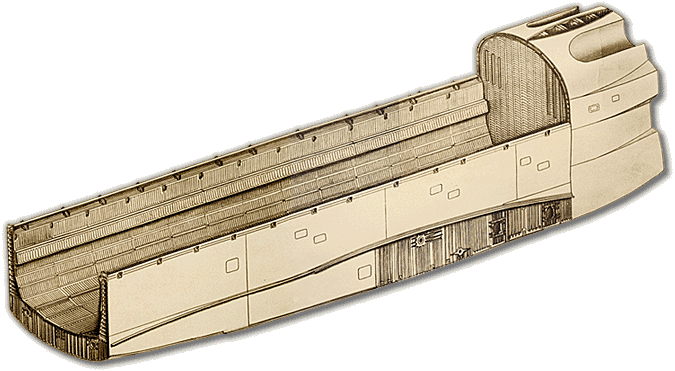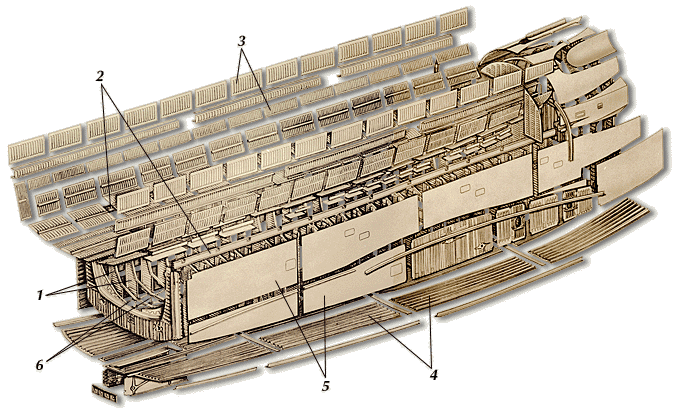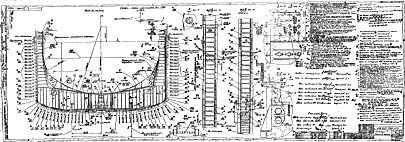

- Buran
- Press release
- Description
- Purpose
- Characteristics
- Composition
- Airfoil
- Nose
- Cockpit
- Onboard computer
- Dashboard
- Wing
- Payload bay
- RMS
- Turbojet
- Vertical stabilizer
- Engine
- Auxiliary power system
- Gear and chute
- Heat Shield
- 37KB module
- Built models
- Safety
- To the orbital flight
- The end
- Gallery
| -The Mriya is destroyed. |
| -Shipping of Buran-KS to Sotchi. |
| -Antonov is no more. |
| -Buran is now a museum. |
| -New pictures of the blogger Ralph Mirebs. |
The payload bay
The central part of the fuselage has a length of 15.5 m, a width of 6 m, and a height 5.5 m and ensures the protection of the payload, the elements of the on-board system and their assembly. This central part is made up of 26 laterals panels and lower panels of the envelope, of strengthening pieces, the doors of the payload bay and the transmission centre with Energia.
Payload bay

The reinforcements structures of the payload bay are divided into 5 types:
- The junction between the payload bay and the cabin, which includes a lower level and 2 upper levels, is done on one hand by the lower level of which the beams are laid out to 20 cm one of the other. Each beam of the lower level includes a central part and 2 side sections, moreover like the central part is requested mechanically it is milled in a titanium plate and is fixed at the cabine module by suspension pieces. On the other hand the upper part includes specific connection elements. The lower part includes the front hook between the Buran shuttle and the Energia launcher.
- The reinforcements laid out in the structure form 2 symmetrical sets, including in the lower and upper zones, joint together by titanium alloy reinforcements.
- Reinforcements laid out on the interior side walls and which form a grid.
- 12 reinforcements which separate in 2 groups (right-hand side and left) at the lower level. They are fixed at the side walls and include fixings for docking the payload.
- 7 reinforcements, of which the structure is similar to those of the preceding point, are charged to support the important constraints of the wings; their lower parts are made out of titanium and are connected to the wings by solids fixings.
The envelope of the payload bay is made up of side and lower panels divided into 4 parts in the direction of the length and fixed by bolts. The panels are welded together and a finer plates cover them on all the fuselage. The panels and the covering are standardized on all over the shuttle.
On the side panels openings are made for the trap doors of the pressurization and ventilation system, trap doors for liquid fuel and oxydizer to the tanks of the power unit. On the left and right sides the outgrowths for the wings in the shape of arc allowing connection between the wings and the fuselage. Lastly, their are access trap doors on the fuselage to fix the side panels.
The central girders of the fuselage are located on the left and right sides and border the doors of the payload bay. Each one of them includes 2 parts, the divisions, and the stiffener, which will form the structure intended to absorb the loads applying to the fuselage. The outward-opening doors of the payload bay are firmly hung by bolts with the stiffeners.
Schematic of the payload bay

Caption:
1-Strengthening pieces; 2-Central girders; 3-Interiors grids; 4-Lower panels; 5-Side panels; 6-Cross-pieces
The payload bay door has a length of 18.5m and a width (measured according to the arc) of 8m form the upper part of the fuselage, and isolate the payload bay from outside. It is made up of 2 doors which include each one 4 sections and are fixed by 12 fastener points on the fuselage. The doors are manufactured based on a titanium alloy, and the cellular panels contain carbon fibre and are agglomerate with a polymeric binder. A metal joint is inserted to avoid the infiltrations of plasma by spaces between the doors and acts also as a thermal joint. In the closed position the doors are fixed according to 17 longitudinal hang and 8 on the extremity. The use of composites matter made it possible to decrease the mass of the doors of 600 kg compared to the metal model.
On the sides of the fuselage 6 trap doors for the pressurization and the ventilation system are laid out according to dimension of 510x220 mm each one, in the upper front zone is located the trap doors for the fuel catch (500x600 mm each one), trap doors open towards the interior but the sealing and the heat insulation are ensured by a special joint.
On the left and right sides the electric cables and fuel pipings are installed for the engines. In the upper zones of the strengthening pieces a coating containing wool is installed in order to improve the heat insulation of the compartment.
The rear part of the fuselage is 3.6 m length, a width of 5.5 m and a 6 m height shelters the equipment of the on-board systems, the hydrosystems and antennas (ОНА-II). On the external is fixed the drift (which is also used as air-brake), the pendulum shield and attached points to Energia. The structure is made up of panels, of central girders of the fuselage, strengthening pieces and beams.
The structure of the tail is made up of a rigidifying part and one not rigidifying. The rigidifying part includes the divisions, the beams manufactured in the titanium plates and perceive the constraints coming from the wings, of the vertical stabilizer and the junction with the Energia launcher; 2 of them are joined by 12 cross-pieces and will form the rigid structure which will absorb the mechanical constraints during the various stages of the flight. The other group supports the unit and ensures the external shape of the tail.
The rigidifying elements include the beams, the upper and lower members. The upper members are the continuation of the beams of the payload bay and receive the constraints of compression and torsion of the fuselage. The lower members are occupied of the constraints of the attached points with Energia. The small central girders support the front and rear flat panels to reduce the deformations appearing due to differences in pressure in the interior of the section.
In the rear part of the tail is laid out a trap door for antenna (ОНА-II) with a trap door opening towards outside. In the closed position the trap door is retained by 10 bolts, the opening and the fence of the trap door being ensured by an electromagnet. The sealing is also obtained by 2 special rubber joints. On both sides fuselage under the horizontal part are located 2 trap doors of exploitation for the access to the section.
Blueprints of the payload bay:
Payload bay blueprint 1

Payload bay blueprint 2

Payload bay blueprint 3

Door of the payload bay

Strengthening pieces N7

Strengthening pieces N26

Strengthening pieces N24

Pendulum shield
